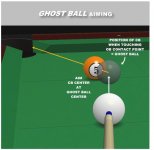It's cumbersome to have a conversation when you nest your comments in blue within my comments the way Spidey does it. I don't think I said things exactly the way I meant. Let me try more specifically after reading your blue comments:
I said you pick a 1/8 section of the ball based on where the pocket is and therefore where the contact point is within 1/8 ball section. To me, this is roughly HAMB but that is not a critical point. Then, I said you thin or thicken the shot with the pivot and you said you do not. However, in your post above you said you choose maybe an A with an inside pivot, a B with outside pivot, etc. The inside pivot thickens the shot while outside thins it, which was what I was trying to say. Once you have made your pivot I understand that you shoot straight through. But, it seems to me what you are doing is essentially aiming at the contact point in a two step process. Step 1: find the 1/8 section where the contact point resides. Step 2: given this location, choose an alignment (what Stan calls a visual) and then either thin or thicken (inside/outside pivot) in order to get you closer to the contact point. This decision is made based on your feel for where the contact point is within that 1/8th section.
If your pivot is always exactly 15* and you have discrete alignments or visuals, then I believe you are relying on either slop in the pocket width or you are fine tuning your pivot more than you realize. After all, these are very small adjustments.
Where did I go off the rails?


